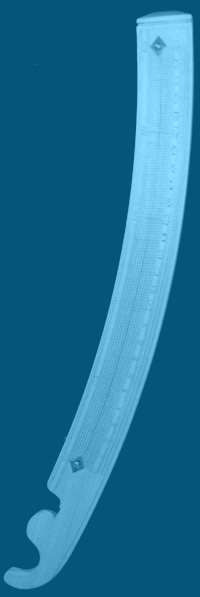1618 Demi-cross (reconstruction)After finishing the spiegelboog (mirror staff) reconstruction I wanted to reconstruct another navigational instrument that no longer exists. A few were on my list and one of them got first: the demi-cross. It is not known who invented the demi-cross, but the shape clearly shows resemblance with the first backstaff Sir John Davis presented in his Seaman's Secrets in 1595. The instrument was first depicted in Blaeu's 1618 't derde deel van 't Licht der Zee-vaert.1 While researching another instrument on my list, the hoekboog, I came across drawings and an extensive description of the demi-cross. The instrument has similar features as the cross-staff, but has an asymmetrical staff and uses a horizon vane and sight vane sliding along it. The cross is only half a cross (hence the name) with on it a shadow vane that can be positioned at four different levels (see figure 2). Although the instrument has been described for at least 72 years by a variety of authors, none of them survived. As none are left I made this reconstruction using the information various authors left in their books. After a year of research, building the instrument took me about 120 hours. Now the instrument should be a 95% accurate reconstruction of the original. A second specimen of this instrument has been made as part of a 17th century navigation set for the rebuilt Dutch factory (trading post) in Hirado, Japan, and can be found on their web site. On November 5th, 2007 a field test was carried out in order to judge the usability of the instrument and to compare it to the Davis Quadrant, which must have been the competitor to this instrument back in the 17th century. I was joined in this test by Nico Duyn, Jan Jonker and Jaap Ypma, all experienced navigators. Compared to the Davis Quadrant the demi-cross was harder to handle due to its size and susceptibility to wind, but it performed much better (see figure 14). When calculating using all the recorded data we find an average error of only -2.0 arc minutes with a standard deviation of 4.9 arc minutes. When calculating using the data from 12:18 onwards (see figure 14) the average error is slightly worse with -2.6 arc minutes, but at 2.3 arc minutes the standard deviation is much better. The Davis Quadrant had an average error +13.7 arc minutes with a standard deviation of 8.5 minutes for all the data and +10.5 arc minutes error with a standard deviation of 5.1 arc minutes as from 12:18. Materials used on this reproduction are ebony for the staff and pear wood for the vanes. In addition to that brass is used for the spring in the cross and the screw in the shadow vane. The horizon vanes have a white painted area. An article on the instrument has been published in bulletin 105 of the Scientific Instrument Society.2 Notes[1]: Although my article on the demi-cross mentions 1621 as the earliest occurrence for the instrument, an earlier work by Blaeu depicting the instrument was found by Djoeke van Netten after the article was published, see:D. van Netten, 'Koopman in Kennis: De uitgever Willem Jansz Blaeu in de geleerde wereld (1571-1638).', in: Y.L. Bleyerveld S. van Bergen, M.T.G.E. van Delft H.M. van den Braber, M. van Vliet J.L. Salman (red.), Bijdragen tot de Geschiedenis van de Nederlandse Boekhandel, Nieuwe Reeks, Deel XV., (Zutphen, 2014), pp. 71-72. [2]: For a full description of the instrument see: N. de Hilster, 'The Demi-cross: a Reconstruction', in: Bulletin of the Scientific Instrument Society No. 105, (2010), pp.30-41. If you have any questions and/or remarks please let me know. |
Celestial Navigation... Coastal Navigation... Distance measurement...
1580s Mariner's astrolabe 1590 Hood's cross-staff 1618 Demi-cross 1623 hoekboog 1660 spiegelboog 1661 Kronan cross-staff 1720 Hasebroek cross-staff 1734 Davis quadrant Early 19th c. ebony octant Late 19th c. brass octant 1941 U.S. Navy quintant Hirado navigation set PhD thesis














